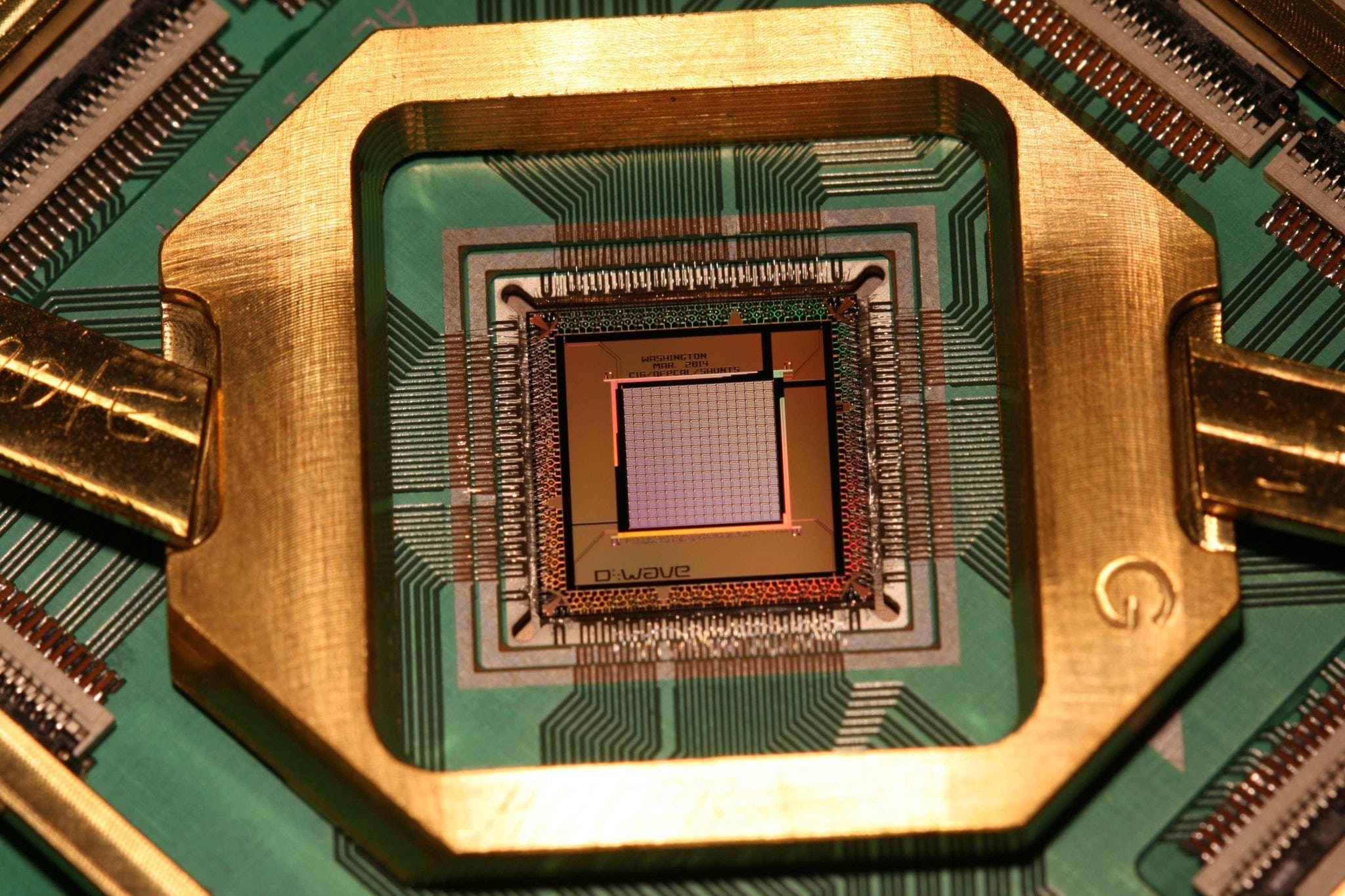[Avionics Today 08-12-2016] Researchers at the University of Southern California (USC) Lockheed Martin Quantum Computing Center (QCC) recently made a major breakthrough in fielding future possibilities for quantum computers. In July, QCC researchers upgraded their existing 512-qubit D-Wave Two system (D-Wave 2X processor) to 1,098 qubits, making it the new leader in qubit capacity. Avionics Magazine recently caught up with Greg Tallant, Lockheed Martin fellow and lead for USC’s QCC, to discuss the center’s latest qubit capacity developments and what future possibilities exist for the aerospace industry’s use of quantum computing.
 |
| D-Wave 1,000 qubit processor. Photo: D-Wave Systems. |
According to Vancouver, Canada-based quantum computing company D-Wave Systems, quantum computing uses atoms rather than transistors to process calculations. Transistors store bits of information in two states, 0s and 1s, whereas quantum computers use quantum mechanics with qubits, which can be 0s or 1s, or any number in-between at the same time. This concept allows quantum computers to process combinations of data simultaneously, making them much faster than anything classical computing technology is capable of.
QCC researchers have been studying the capabilities of D-Wave Systems’ D-Wave quantum annealing processors since 2011, starting with the first commercially released model of their initial 128-qubit system, which was upgraded to 512 qubits two years ago, and most recently to 1,098 qubits. The new processor will be used to study how and whether quantum effects can speed up the solution of tough optimization, machine learning and sampling problems. Machine learning algorithms are widely used in artificial intelligence tasks. Engineers within the aerospace industry and many other industries expect the processing power of quantum computers to be able to greatly improve computer modeling and simulation.
Tallant says the main focus of the research currently is to aid in helping solve a problem that exists within avionics and all computing software development: the problem of Verification and Validation (V&V).
“One of the important problems that exists in aviation and really all software development in general, is making sure the software system being developed is what you intended it to be. The verification and validation of software is a complex problem to solve, it’s very time consuming and expensive as well; quantum computing has the potential to help us be more efficient in resolving V&V,” said Tallant.
Aircraft system software is safety critical, and is among the most heavily regulated and certified software to develop and integrate across all major technological industries. Companies such as Lockheed Martin, put a great deal of effort into ensuring that aircraft system software is correct. The F-35’s eight million lines of code are an excellent example of this. Tallant believes quantum-computing technology could give software developers the ability to achieve capabilities, such as rapidly debugging millions of lines of software code and resolving complex aerospace computational problems.
“Aviation software applications that are designed to aid in the routing and scheduling of aircraft, and doing so in the most cost effective way, calculating how much fuel is required for a commercial aircraft to arrive at an airport or even at a waypoint through its flight plan, these are the types of problems that quantum computing can aid. Machine learning is another area that is huge and it has huge potential in the commercial sector as well as in defense,” said Tallant.
QCC isn’t alone in its efforts to push quantum-computing technology forward. The USC-Lockheed Martin QCC hosts one of two D-Wave systems that currently operate outside of D-Wave’s headquarters. The other system is owned by Google and hosted at NASA’s Ames Research Center. A third is being installed at Los Alamos National Laboratory, according to QCC.
One of the aviation industry’s biggest names, Airbus, has also shown an interest in quantum computing technology, mainly in using the concept to speed up aircraft research. In 2015, Airbus Defense and Space established a quantum computing unit at its Newport, U.K. plant. One particular application the company is exploring the use of quantum computing for is digital modeling and simulation. While it currently takes engineers years to model the process of air flowing over a wing, a quantum computer could take just a few weeks to model every single atom of air flowing over a wing at all angles and speeds.
Tallant said optimization is one of the primary uses of quantum computing his team is looking at, and he uses the example of using computer applications to assess the optimal amount of fuel and the optimal speed at which to operate a commercial aircraft. But could quantum computing actually be applied to embedded avionics systems? At this point, it could be a decade or more before manufacturers can use quantum processors inside of Flight Management Computers (FMC), he says, but it is good to at least know what possibilities exist.
“That’s something that is a longer term, much further down the road before we get to the point where you can potentially fly around a quantum processor itself. The kinds of optimization problems we can target in the near term, the next three to four years, would require problems that can be solved in an offline fashion. The quantum computer is more of a traditional mainframe type of device at least right now. With the D Wave, you cannot carry that around on the airplane and put it in a flight management system. The technology isn’t mature enough yet to where we’re going to be able to build embedded systems, I think we’re still a decade or so away from that becoming a serious possibility,” said Tallant.